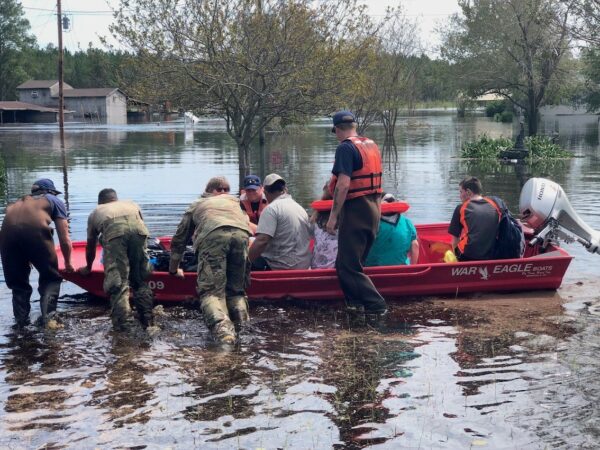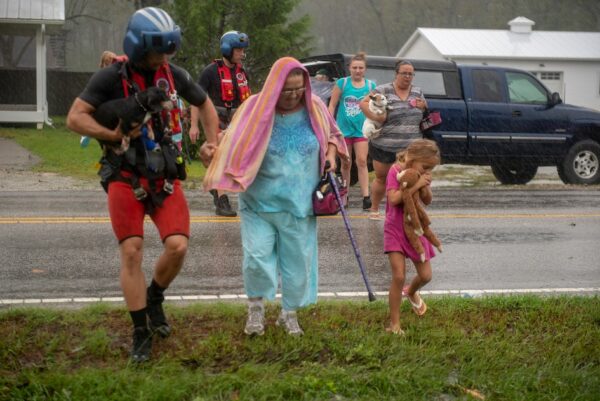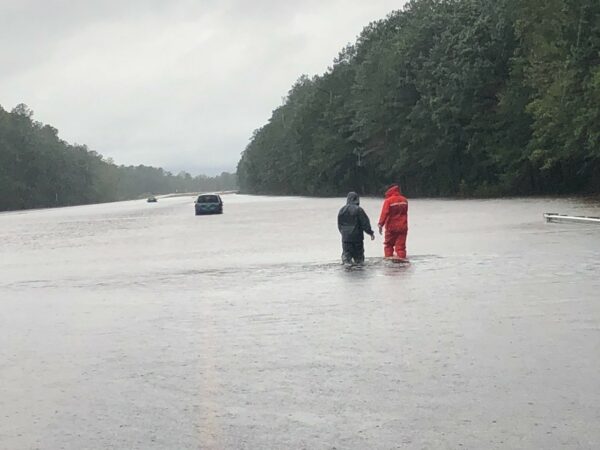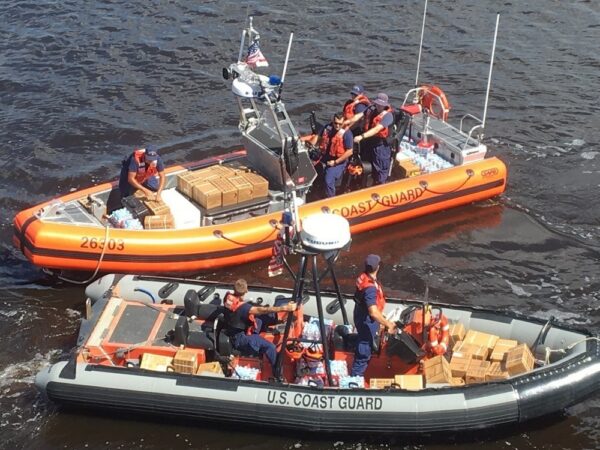As some North Carolinians were returning to their homes and recovering from 2016’s Hurricane Matthew, a new storm was tracking toward the East Coast. On Friday, Sept. 14, 2018, at 7:15 a.m., Hurricane Florence made landfall at Wrightsville Beach, North Carolina, with sustained winds of 90 miles per hour. However, the flooding associated with Florence would prove even more devastating than just hurricane-force winds. Hurricane Florence dropped more than 33 inches of rain in portions of North Carolina, causing widespread destruction that people could never have imagined.
Florence created more challenges for Coast Guard responders than the usual storm response. The hurricane closed with the southeast U.S., a region with a large Coast Guard population, so service men and women had the added responsibility of preparing their own homes and families while planning for a large-scale recovery effort. Every Coast Guard member from Jacksonville, Florida, to Northern Virginia, kept an eye on the weather. For this storm, the safety of service members’ families was essential when deciding whether to evacuate loved ones to a safe area while planning for a response.

After responding to the 2017 hurricanes season, including hurricanes Harvey, Irma, Nate, and Maria, the Coast Guard spent nine months reviewing the successes and challenges it faced in that eventful year. Accordingly, when Florence’s path began tracking toward the East Coast, the Coast Guard was ready once again to live-up to its motto, Semper Paratus–“Always Ready.”
Setting the stage to establish Unified Commands that manage response operations while preparing their own homes for the storm, Coast Guard personnel identified Incident Command Post (ICP) locations in Georgia and the Carolinas. Identifying ICP locations is a challenge. An ideal spot places Coast Guard members in structures that can withstand high winds and flooding, maintain power and communication capabilities, and remain in close proximity to provide a rapid response once the storm has passed. In addition, because hurricane paths often shift within 24 hours of making landfall, several locations are normally set up to ensure a robust response no matter where the storm hits. For Hurricane Florence, personnel and assets were staged in multiple locations near the ICPs. These assets included, but were not limited to, aircraft, shallow-water response boats, cutters, medical teams, communication teams, and numerous support personnel necessary for the response.

On that Friday morning, as the storm passed through the Carolinas, the Coast Guard was poised to respond as soon as possible. Helicopter crews performed rescues the day after the storm. Flying an MH-60, Lt. Weston Dodson and his crew deployed to Rocky Point, North Carolina, a town inundated with floodwaters, to respond to a family distress call. The crew landed in a grassy field and rescue swimmers Chris Fisher and John Fuller left the aircraft to locate the family. Two local teachers greeted the Coast Guardsmen and volunteered to assist in rescue operations in an area cut-off by flooding. The teachers took the rescue swimmers to a family in distress, but as the aircrew began evacuation, the teachers brought more victims needing help. The crew loaded as many families as possible into the helicopter and flew them to safety before returning for more survivors.

Rain began blanketing the neighborhood causing floodwaters to rise rapidly. The teachers refused to leave their community. The rescue swimmers pleaded with the educators and eventually convinced them to leave. The two teachers were the last of the 37 community members rescued by that helicopter crew.
Coast Guard helicopters played a vital role in Hurricane Florence rescue operation, but this hurricane was a flooding event and flooding events require boats. The Coast Guard deployed 23 shallow-water response boats throughout the rescue effort. On September 19, as Chief Petty Officer Sean Reddick was preparing to launch small boats in the floodwaters surrounding Pollocksville, North Carolina, a distressed man approached Reddick and pleaded for help. The man explained how he and his pregnant wife left before Florence’s landfall when his wife went into labor. He had planned to return the next day to prepare his home for the storm and retrieve his dogs. However, his wife experienced complications, and his newborn baby was placed in the Intensive Care Unit, forcing them to stay at the hospital until the storm passed and the floodwaters receded. Reddick placed the man on a boat with petty officers Andrew Hubert, Taylor Foran and Zachary Hupp. The boat crew took the man to his home, which was surrounded by water, and waited for him to search for his dogs. After what seemed an eternity, he joyfully returned from his house with his two dogs and medical supplies for his wife.

While aircraft and shallow water response crews rescued people and pets from floodwaters, Wilmington, North Carolina-based cutter Diligence was patrolling in the Caribbean. The cutter reversed course to return to its devastated homeport. Diligence stopped briefly in Miami to load relief supplies, then steamed directly for the Carolinas. As Diligence approached the city, Robert Mohr, commanding officer, ordered the cutter’s smallboats launch for reconnaissance up the Cape Fear River. The boat crews stopped at Bald Head Island, which was running out of food and potable water, and then returned to Diligence to load 550 ready-to-eat meals and over 1,000 bottles of water. In the following days, Diligence delivered more meals and potable water to local marinas and restored the region’s offshore search and rescue services.

These are just a few examples of the Coast Guard’s hurricane response. The service rescued or assisted over 900 victims and 300 pets in North Carolina and South Carolina as Florence moved through. Over 3,000 Coast Guard men and women participated in this response effort on board multiple cutters, 35 shallow-water rescue boats, and 28 aircraft. The service also supported partner agencies in their response efforts.
A hurricane of Florence’s magnitude is never a good thing, but the men and women of the U.S. Coast Guard take pride in knowing their skills and training save lives and they will always remain Semper Paratus to answer the call.
National Coast Guard Museum insider tip: The National Coast Guard Museum will cover the numerous, moving, and heroic hurricane rescues in the Lifesavers Around the Globe wing on Deck 2.
